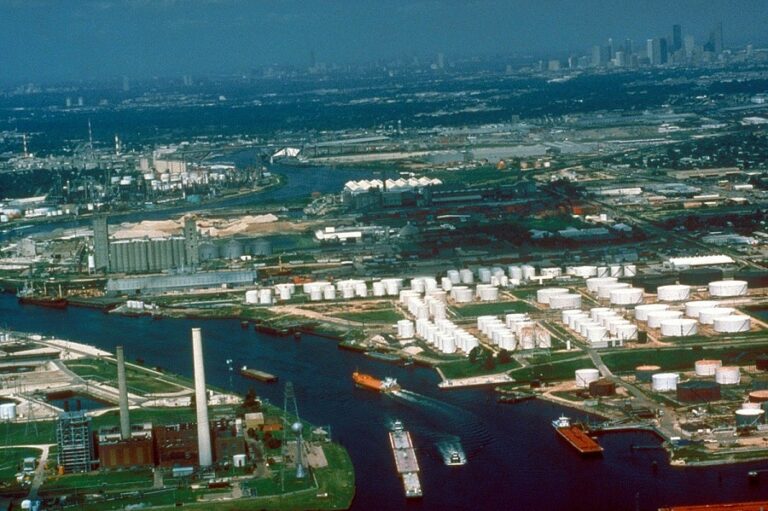The Gulf of Mexico is the gateway to freight, in terms of imports to the United States and exports from American owned businesses. Did you know that Texas actually has seven ports, and all of them rank in the top 50 in terms of managed tonnage out of all domestic locations? When you look at the importance of Houston Texas as a depot for international and domestic imports and exports, we’ve got a lot to be proud of.
The seven ports located in Texas are:
- Galveston
- Houston
- Beaumont
- Corpus Christi
- Texas City
- Brownsville
- Port Arthur
How important is port freight and drayage to the Texas economy? According to the Texas Ports Association, they account for more than $800 billion dollars of economic activity in Texas, and almost $38.1 billion dollars in tax revenues. Only Port of Houston is rated as a ‘very large’ port however, dedicated to container freight processing.
The expansion of the Panama Canal in June, 2016 only served to create an increased surge in container traffic and vessels to the Port of Houston in Texas. The Maritime Division and the Texas Freight Advisory Committee are responsible for coordinating all the planning efforts, infrastructure improvements and freight movement through Texas ports and harbors. We’d like to share some interesting historical facts that you may not know about the Port of Houston.
The Beginning of the Houston Ship Channel
It’s hard to visualize Port Houston as anything but large, but in the early days and around 1826, a man named John Richardson Harris was responsible for starting ocean commerce in the area. He created the town of Harrisburg Texas, which was located on Buffalo Bayou, where he built a steam mill.
Harris owned a schooner called “The Rights of Man” and navigated through Galveston Bay and Buffalo Bayou to manage his import supplies, while exporting cotton and animal hides and leathers. At that time, there was almost no population around the Buffalo Bayou area, because most people were more interested in settling where agriculture was good, in the Brazos Valley.
Another business man named Nicholas Clopper saw that Harris had a thriving business, and decided to purchase land downstream from Harrisburg, and called it “Cloppers Point”. Clopper also owned a schooner (Little Zoe) and imported essentials like flour and spices, hardware and building materials, tobacco and whiskey.
Galveston Bay was quickly developing a reputation for being hazardous to navigate, and Clopper’s schooner Little Zoe was one of the unfortunate ships to run aground, getting stuck in Red Fish Bar. But by the late 19th century, the importance of Galveston Bay for commerce forced local government to invest in dredging the area to accommodate larger vessels. The Galveston hurricane in the year 1900 convinced the business community that extending deeper inland toward Port of Houston was a safer bet, and that’s when the planning of the large ship canal began.
Dredging to Increase Vessel Traffic and Freight Volume in Houston
The first government funded dredging of the Houston Ship channel began when residents of Harris County voted unanimously to invest in the project. The Houston ship channel was dredged to a depth of 25 feet for the outrageous cost of $1,250,000. But it would be an economic investment that would definitely pay off. The first deep water vessel called the Satilla arrived on June 14, 1914. It was a steamboat that would open shipping lanes between New York City and Houston. Later that year in November, President Woodrow Wilson official opened the ship channel, and it became a vital link for oil supply during World War I.
The wider and deeper the channel got, the more business flowed into the Houston area. So, in 1922 the United States Army Corps of Engineers further increased the depth of the channel to 30 feet. In 1933, it was deepened further to 34 feet and widened the Galveston Bay section from 250 feet to 400 feet, for a sum investment of almost $3 million dollars in 1936.
Because the Port of Houston was such an engineering feat for its time (and economically important) it was designated as a National Civil Engineering Landmark by the American Society of Civil Engineers in 1987.
The Port of Houston is Still Growing Today
Port Houston is one of the busiest seaports in the world for inland barge traffic. The Houston Ship Channel was created by dredging Buffalo Bayou and Galveston Bay, to create a depth that would accommodate large ocean vessels for container traffic. Large vessels can navigate to Turning Basin in East Houston within the channel.
The Houston Ship Channel is 530 feet wide by 45 feet deep, and over 50 miles long. There are five channel crossings for drayage truck traffic, which are the Washburn Tunnel, Sidney Sherman Bridge, Sam Houston Ship Channel Bridge (Beltway 8 Bridge), the Fred Hartman Bridge (which connects La Porte and Baytown) and the Lynchburg Ferry.
Terminals at the Port of Houston Texas and berthing locations are spread along Buffalo Bayou and Galveston Bay. The largest public terminals are Turning Basin, Barbours Cut and Bayport. Large corporations such as Exxon Mobile and Deer Park have their own private complexes and docks.
The Texas Chicken Maneuver You Might Be Lucky Enough to See at Port Houston Texas
If you ever visit the Port of Houston to watch the large ocean vessels travel up and down the Houston Ship Channel, watch for a special trick that marine captains use in the somewhat narrow channel. It’s called the “Texas Chicken” maneuver. Two vessels approach from different directions, and turn starboard abruptly to allow the water or wake from the bows to move ships safely away from each other, on the centerline of the channel.
After the ships have passed, the natural suction of that displaced water flows in behind the large vessels, and pulls them back toward the center of the waterway. It’s pretty neat to watch, if you get the opportunity to see it, and something unique to the Port of Houston, given the dynamics and size of the channel.
If you have been raised in Houston Texas, chances are you’ve had a family member or two who was employed at the Port of Houston. We’re proud of our heritage, our rich local history of commerce, and the continued role that Port Houston plays in the economic development and success of the City of Houston.
Photo: Wikipedia



